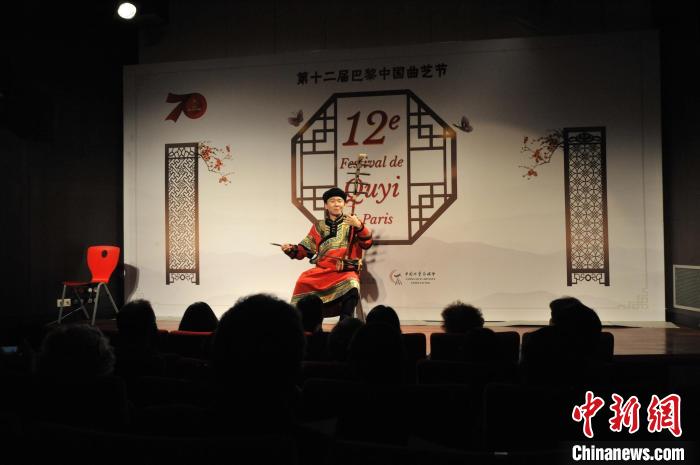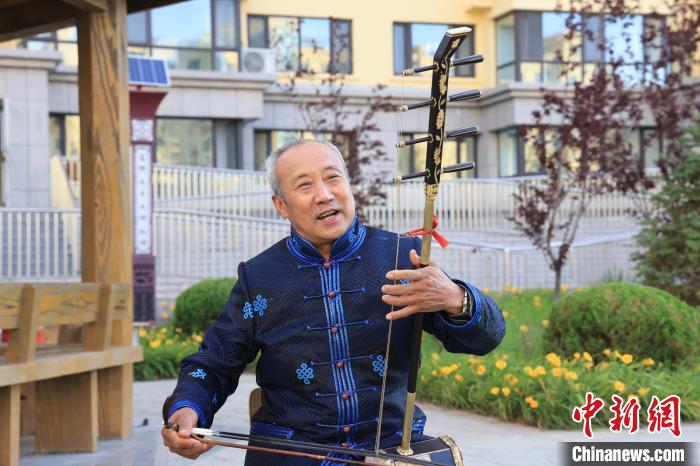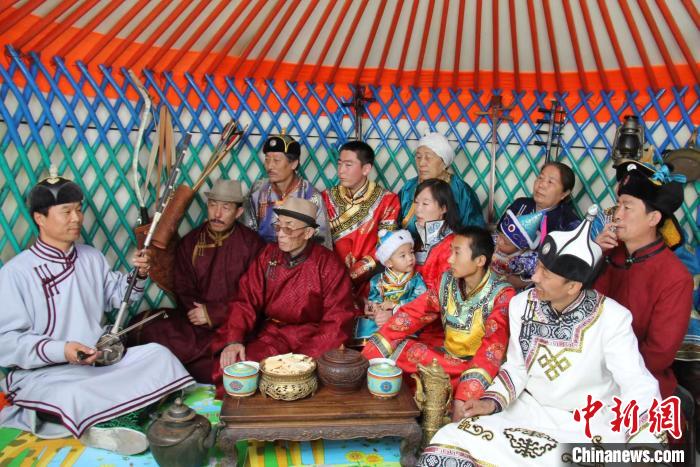Uliger: Distinctive Mongolian ethnic 'rap music' enriches lives of herdspeople in China
Uliger, a traditional Mongolian storytelling folk art dating back to China's late Ming Dynasty (1368-1644) and early Qing Dynasty (1644-1911), continues to fascinate people of the Mongolian ethnic group in China, while capturing the hearts of listeners from other regions with its timeless appeal in the modern era.
Uliger has deep roots in Mongolian pastoral life. The Mongolian saying "You can go three days without eating, but not a day without storytelling" speaks to the deep importance of storytelling in the daily life of the Mongols.

Photo taken in 2019 shows Li Gegenzhuge, a sixth-generation inheritor of traditional Mongolian storytelling folk art Uliger, performing Uliger in Paris, France, at an event marking the 55th anniversary of the establishment of diplomatic relations between China and France. (Photo courtesy of the interviewee)
With its vast range of topics, from astronomy and geography to the natural sciences and everyday life, Uliger has long served as the soundtrack to the lives of herdspeople inhabiting vast grasslands.
The distinctive folk art primarily exists in two forms: one is a vocal performance without any instrumental accompaniment, known as Yabagan Uliger, and the other involves musical instruments, making it akin to modern-day rap music or hip-hop.
Li Gegenzhuge, a sixth-generation inheritor of Uliger, recently mesmerized the audience with a rendition of the classic Mongolian epic "Jangar" at a 2025 New Year gala featuring Chinese folk-art forms, held in north China's Inner Mongolia Autonomous Region.
The performance, accompanied by the enchanting sounds of Sihu, a four-stringed traditional Chinese bowed instrument, blended striking musicality with vivid storytelling.

Photo taken in the summer of 2024 shows Ganzhuer performing Uliger for public welfare to promote traditional Chinese culture. (Photo courtesy of the interviewee)
During the performance, Li's left hand deftly plucked the strings while his right hand skillfully drew the bow. The music flowed in a dynamic range, sometimes producing sounds like galloping steeds, and at other times, the clash of swords and spears.
The detailed character portrayal, coupled with expressive body movements, gestures, and footwork, brought the story to life, immersing the audience in the emotions of the narrative.
"Uliger performances on the grasslands are simple, unrestricted by the environment. A storyteller can sit anywhere—be it in a yurt or out in the grasslands—and with a horse head fiddle or Sihu in hand, they can begin telling stories, rapping along with the music," Li said.
Uliger is not merely "storytelling" in the literal sense, nor is it the same as traditional music of the Mongolian ethnic group, according to Li.
"Uliger is highly musical, with strong rhythms and a deep narrative structure," he explained. "The narrative is brought to life with vivid metaphors, parallel sentences, and a melody that shifts with the emotional weight of the story."
"The songs, sung in Mongolian, are rhythmic and poetic, typically following a pattern of three to five words per line, with four-line verses that rhyme," Li added.
Experienced Uliger performers can often improvise based on a given subject, adapting their delivery to the request, he noted.
"Uliger reflects the thoughts, emotions, loves, and aspirations of the Mongolian people," said Li's mentor, Ganzhuer.

Photo taken in the summer of 2015 shows people enjoying a performance of traditional Mongolian storytelling folk art Uliger inside a yurt. (Photo courtesy of the interviewee)
"It has rich ideas, vivid stories, heart-touching characters, beautiful language, and unique ways of expression," the master said, noting that more often than not, the performances, with just one instrument, can evoke images of everything from swords and steeds to tools like sickles and whips.
As a post-95s young man born and raised on the vast Horqin Grassland in Inner Mongolia, Li has been immersed in Uliger from a young age, learning the craft from his grandfather and father.
He desires to introduce this special art form to a wider audience.
Not long ago, he took his performances to Europe, where he met with widespread acclaim from local audiences, further boosting his confidence in Uliger's potential to reach a global audience.
Photos
Related Stories
- From China to America, Pipa virtuoso stirs souls, tugs heartstrings
- Monkey King, Li Bai, hotpot: U.S. trumpet master jazzes up Chinese musical heritage
- Mining gold of music: eternal passion of Chinese 99-year-old conductor
- Gen-Z musicians inject vitality into traditional Chinese musical instruments
- 'Wukong' rap track debuts
- Spanish musicians' cross-cultural musical journey
- Trending in China | The dulcet tones of the Hulusi flute
- Trending in China | The soul-purifying music of the Guqin
- Feature: Music provides cultural bridge between China, Italy
- Nine concerts in 11 days, Philadelphia Orchestra wraps up China tour
Copyright © 2025 People's Daily Online. All Rights Reserved.









